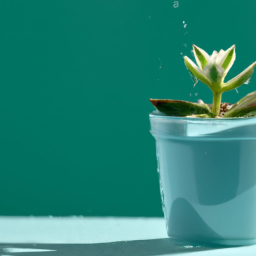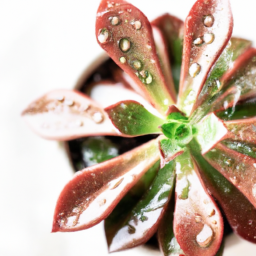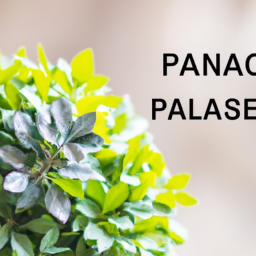
Are you looking to create a more sustainable living environment? If so, then you’ve come to the right place. In this blog post, we will explore the world of plants that thrive on less water, helping you make wise choices for your sustainable lifestyle. By selecting these water-efficient plants, you can not only conserve water but also create a beautiful and thriving garden. So, let’s dive in and discover the best choices for sustainable living – choose wisely: plants that thrive on less water.
Benefits of Choosing Water-Efficient Plants for Sustainable Living
When it comes to sustainable living, one of the key factors to consider is water conservation. By choosing water-efficient plants for your garden or indoor space, you can significantly reduce your water consumption while still enjoying the beauty and benefits of greenery. In this article, we will explore the numerous advantages of selecting plants that thrive on less water, and provide you with a step-by-step guide on how to make the best choices for your sustainable lifestyle.
Reduced Water Usage
One of the most obvious benefits of choosing water-efficient plants is the significant reduction in water usage. Traditional lawns and gardens can consume a staggering amount of water, especially in arid regions or during dry seasons. By opting for plants that require less water, you can conserve this precious resource and contribute to a more sustainable future. Water-efficient plants have adapted to survive in drier conditions, which means they can thrive with minimal irrigation and still look vibrant and healthy.
Moreover, reducing water usage not only benefits the environment but also your wallet. By selecting plants that require less frequent watering, you can save money on your water bills and allocate those funds towards other sustainable initiatives or investments.
Additionally, water-efficient plants often have deep root systems that help them access water from deeper soil layers or store water efficiently. These characteristics allow them to withstand droughts and dry spells, making them more resilient and less dependent on regular watering.
Biodiversity and Ecosystem Support
Another advantage of choosing water-efficient plants is their positive impact on biodiversity and ecosystem support. Native water-efficient plants, in particular, play a crucial role in providing habitat and food sources for local wildlife, including birds, butterflies, and bees. By incorporating these plants into your landscape, you can create a thriving ecosystem that supports a diverse range of species.
Furthermore, water-efficient plants can help prevent soil erosion and improve soil quality. Their extensive root systems bind the soil together, reducing the risk of erosion caused by heavy rainfall or wind. These plants also contribute to the enrichment of the soil by adding organic matter and enhancing its water-holding capacity. As a result, your garden becomes more resilient and better equipped to withstand extreme weather conditions.
Moreover, water-efficient plants can improve air quality by absorbing carbon dioxide and releasing oxygen through the process of photosynthesis. This natural air purification helps reduce pollution and creates a healthier environment for you and your community.
Low Maintenance and Versatility
Water-efficient plants are often low maintenance, requiring less time and effort to care for compared to traditional plants. Their ability to thrive on less water means you can spend less time watering and more time enjoying your garden or indoor plants. This is particularly beneficial for busy individuals or those who may not have easy access to water sources.
Additionally, water-efficient plants come in a wide variety of shapes, sizes, and colors, offering endless possibilities for creative landscaping. Whether you prefer a lush garden, a vibrant flower bed, or a collection of potted plants, there are water-efficient options available to suit your preferences. These plants can be used to create visually appealing landscapes while still conserving water and promoting sustainable living.
In conclusion, choosing water-efficient plants for sustainable living brings numerous benefits. From reducing water usage and saving money to supporting biodiversity and creating low-maintenance landscapes, these plants offer a practical and eco-friendly solution for those looking to make a positive impact on the environment. By following the steps outlined in this guide, you can confidently select the right water-efficient plants for your sustainable lifestyle and contribute to a greener future.

Choose Wisely: Plants That Thrive on Less Water for Sustainable Living
Top Drought-Tolerant Plants That Thrive in Low-Water Conditions
When it comes to sustainable living, choosing plants that require less water can make a significant difference in conserving this precious resource. Not only do drought-tolerant plants help reduce water consumption, but they also thrive in low-water conditions, making them perfect for regions with limited water availability or for individuals looking to minimize their water usage.
The Benefits of Drought-Tolerant Plants
Drought-tolerant plants have several advantages that make them an excellent choice for sustainable living. Here are some key benefits:
- Water Conservation: Drought-tolerant plants have evolved to survive with minimal water, reducing the need for excessive irrigation. This helps conserve water resources and promotes sustainable gardening practices.
- Low Maintenance: These plants are typically low maintenance, requiring less time and effort to care for. They are well-adapted to survive in arid conditions, making them ideal for busy individuals or those with limited gardening experience.
- Resilience: Drought-tolerant plants are hardy and resilient, capable of withstanding dry spells and extreme temperatures. They can endure periods of water scarcity and still thrive, ensuring a beautiful and vibrant garden even during challenging times.
- Biodiversity: By choosing drought-tolerant plants, you contribute to the preservation of biodiversity. These plants often attract unique pollinators and wildlife, creating a more balanced and sustainable ecosystem in your garden.
Choosing the Right Drought-Tolerant Plants
When selecting drought-tolerant plants for your garden, it’s essential to consider various factors such as climate, soil conditions, and available sunlight. Here are some steps to help you choose wisely:
- Research: Start by researching plants that are native to your region or those that thrive in similar climatic conditions. Native plants are well-adapted to the local environment and require minimal water once established.
- Water Needs: Look for plants that have low water requirements. Check their water needs in terms of frequency and quantity. Opt for plants that can survive with infrequent watering or those that can tolerate dry spells.
- Soil Adaptability: Consider the soil type in your garden. Some drought-tolerant plants prefer well-drained soil, while others can thrive in sandy or rocky soils. Choose plants that can adapt to your specific soil conditions.
- Sunlight Requirements: Assess the amount of sunlight your garden receives throughout the day. Some plants thrive in full sun, while others prefer partial shade. Select plants that match the sunlight availability in your garden.
- Plant Diversity: Aim for a diverse selection of plants to create an aesthetically pleasing and ecologically balanced garden. Mix different colors, textures, and heights to add visual interest and support a wider range of wildlife.
- Consider Watering Techniques: Implement water-saving techniques such as drip irrigation or mulching to further reduce water consumption. These techniques can help deliver water directly to the plants’ roots while minimizing evaporation.
Popular Drought-Tolerant Plants
Now that you understand the benefits of drought-tolerant plants and how to choose them wisely, let’s explore some popular options to consider for your sustainable garden:
1. Lavender
Lavender is a beautiful and fragrant herb that thrives in dry and sunny conditions. It requires minimal water once established and attracts pollinators like bees and butterflies. Lavender’s soothing aroma also adds a calming element to your garden.
2. Succulents
Succulents are known for their ability to store water in their leaves, stems, or roots, making them highly drought-tolerant. They come in various shapes and sizes, adding a unique and eye-catching element to your garden. Popular succulent varieties include Echeveria, Aloe Vera, and Sedum.
3. Rosemary
Rosemary is a versatile herb that thrives in hot and dry climates. It requires minimal watering and adds both culinary and aromatic value to your garden. Rosemary is also known to repel certain pests, making it a beneficial addition to any garden.
These are just a few examples of drought-tolerant plants that can thrive in low-water conditions. Remember to consider your specific climate and growing conditions when selecting plants for your sustainable garden.
Conclusion
By choosing drought-tolerant plants for your garden, you can significantly reduce water consumption while still enjoying a vibrant and beautiful landscape. The benefits of these plants extend beyond water conservation, as they require less maintenance, promote biodiversity, and exhibit resilience in challenging conditions. Follow the steps outlined in this guide to choose wisely and create a sustainable garden that thrives on less water.

Choose Wisely: Plants That Thrive on Less Water for Sustainable Living
3. Tips for Creating a Water-Wise Garden: Plant Selection and Conservation Techniques
Creating a water-wise garden is not only beneficial for the environment but also for your wallet. By choosing plants that thrive on less water, you can reduce your water consumption and still enjoy a beautiful and sustainable garden. In this article, we will provide you with tips on plant selection and conservation techniques to help you create a water-wise garden.
Plant Selection
When it comes to plant selection for a water-wise garden, it’s important to choose plants that are native to your region. Native plants are well-adapted to the local climate and require less water compared to non-native species. They have evolved to survive with minimal rainfall and can thrive even during drought conditions. Additionally, native plants provide habitat and food for local wildlife, contributing to the overall biodiversity of your garden.
Another factor to consider is the plant’s water requirements. Some plants naturally require less water to thrive, while others are more water-intensive. By choosing plants with low water needs, you can significantly reduce your water usage. Drought-tolerant plants such as succulents, cacti, and Mediterranean herbs like rosemary and lavender are excellent choices for a water-wise garden. These plants have adapted to arid conditions and can store water in their leaves or stems, reducing their reliance on regular watering.
Furthermore, consider the growth habit and size of the plants. Opt for slow-growing plants that won’t outgrow their space quickly. This will minimize the need for frequent pruning and reduce the water requirements. Grouping plants with similar water needs together can also help in efficient watering and prevent water wastage.
Conservation Techniques
In addition to plant selection, implementing conservation techniques can further enhance the water efficiency of your garden. Here are some tips:
1. Mulching: Applying a layer of mulch around your plants helps to retain moisture in the soil, reducing the need for frequent watering. Organic mulches like wood chips or straw not only conserve water but also improve soil fertility and prevent weed growth.
2. Irrigation: Opt for efficient irrigation methods such as drip irrigation or soaker hoses. These systems deliver water directly to the plant roots, minimizing evaporation and water waste. Install a rainwater harvesting system to collect and store rainwater for later use in your garden.
3. Soil Preparation: Prepare your soil by adding organic matter like compost or well-rotted manure. This improves the soil’s ability to retain moisture and promotes healthy root growth. Well-draining soil allows excess water to escape, preventing waterlogging and root rot.
4. Watering Schedule: Water your plants deeply and less frequently. This encourages deep root growth and makes plants more resilient to drought. Avoid watering during the hottest part of the day to minimize evaporation. Instead, water early in the morning or late in the evening when temperatures are cooler.
5. Maintenance: Regularly inspect your garden for leaks in irrigation systems or faucets. Fix any leaks promptly to prevent water waste. Remove weeds that compete with your plants for water and nutrients. Weeds can quickly deplete soil moisture, affecting the health of your water-wise plants.
By following these plant selection and conservation techniques, you can create a water-wise garden that not only saves water but also adds beauty and sustainability to your outdoor space. Remember, every drop counts, and by making conscious choices, you can contribute to a greener and more water-efficient future.
In a Nutshell
Are you looking to create a more sustainable lifestyle? One way to do so is by choosing plants that require less water. Not only will this help conserve water, but it can also save you time and effort in maintaining your garden. In this blog post, we will explore a few plant options that thrive on less water, allowing you to create a beautiful and sustainable garden.
One plant that is known for its ability to withstand drought conditions is the succulent. Succulents have thick, fleshy leaves that store water, enabling them to survive in arid environments. These plants come in a variety of shapes, sizes, and colors, making them a versatile choice for any garden. Some popular succulent options include aloe vera, jade plant, and echeveria. With their low water requirements and unique aesthetic, succulents are a great choice for sustainable gardening.
Another plant that is well-suited for sustainable living is the lavender. Lavender is a hardy perennial herb that thrives in dry conditions. This fragrant plant not only adds beauty and color to your garden but also attracts pollinators like bees and butterflies. Lavender requires minimal watering once established, making it an excellent choice for those looking to conserve water. Additionally, this versatile plant can be used for various purposes, such as making essential oils or adding flavor to culinary dishes. So, if you’re looking to create a sustainable garden that is both visually appealing and functional, consider adding some lavender to your landscape.
By choosing plants that require less water, you can make a positive impact on the environment while still enjoying a beautiful garden. Whether you opt for succulents or lavender, these low-water plants are sure to thrive in your sustainable living space. So, go ahead and choose wisely – your garden and the planet will thank you!
Frequently Asked Questions from our readers:
Q1: What are some plants that thrive on less water for sustainable living?
A1: There are several plants that are well-suited for sustainable living and require less water to thrive. Some popular choices include succulents like aloe vera and jade plants, as well as drought-tolerant flowers such as lavender and yarrow. Additionally, native plants like cacti and agave are excellent options for conserving water while still adding beauty to your garden.
Q2: How do plants that require less water contribute to sustainable living?
A2: Plants that require less water play a crucial role in sustainable living by reducing water consumption. By choosing these plants, you can conserve water resources, lower your water bills, and minimize the strain on local ecosystems. Moreover, since these plants are adapted to survive in arid conditions, they generally require less maintenance and are more resilient to drought.
Q3: What are some tips for caring for plants that thrive on less water?
A3: To ensure the health and vitality of plants that thrive on less water, here are a few tips to keep in mind:
– Choose well-draining soil to prevent waterlogging.
– Water deeply but infrequently, allowing the soil to dry out between watering sessions.
– Apply mulch around the plants to retain moisture and suppress weed growth.
– Avoid over-fertilizing, as excessive nutrients can increase water needs.
– Position plants in areas with adequate sunlight and airflow to promote their natural resilience.
Q4: Can plants that thrive on less water be grown indoors?
A4: Yes, many plants that thrive on less water can be successfully grown indoors. Succulents, such as the popular snake plant and ZZ plant, are excellent choices for indoor environments due to their ability to store water in their leaves. Additionally, certain herbs like rosemary and thyme can adapt well to indoor conditions and require less frequent watering.
Q5: Are there any other benefits to choosing plants that require less water?
A5: Absolutely! Besides their contribution to sustainable living, plants that require less water offer various additional benefits. They often attract pollinators like bees and butterflies, enhancing biodiversity in your garden. Moreover, these plants can withstand dry spells and are generally more disease-resistant, reducing the need for pesticides or chemical treatments. Lastly, they can add a unique aesthetic appeal to your landscape with their diverse shapes, textures, and colors.

James Wong is a renowned ethnobotanist, plant scientist, and local television presenter. With a passion for demystifying plant science, he is known for translating complex botanical concepts into practical advice for everyday plant enthusiasts. James’s expertise spans from traditional gardening to cutting-edge plant technologies, making his insights accessible and informative.


